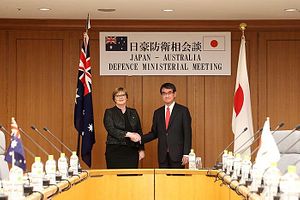Last week Australian Defense Minister Linda Reynolds made her first official visit to Tokyo, holding talks with her counterpart, Taro Kono. The two ministers reiterated their commitment to the security relationship between the two countries, and consolidated a series of new measures designed to deepen their defense cooperation. These developments have consolidated the perception that Tokyo and Canberra now see each other as their most important — and reliable — security partner after their respective alliances with the United States.
Australia and Japan signed a Joint Declaration on Security Cooperation in 2007. Since then there has been a consistent effort to enhance the security pact. The relationship further developed as a Comprehensive Partnership in 2008, and was elevated to Special Strategic Partnership in 2014. Over this period — and into the present — bilateral and trilateral (with the U.S) military exercises have been regularly conducted, including combat operations, anti-submarine warfare, and most recently between their respective air forces. Information and technology sharing has also increased.
The two defense ministers further progressed the relationship by announcing that the countries’ first bilateral fighter jet exercise held — Bushido Guardian — that took place in September and October, would be become a regular bilateral exercise. This would also lead to Japan becoming a regular participant in the Australian Air Force’s exercise Pitch Black, held biennially in northern Australia. Japan would increase its participation in the Australia-U.S joint exercise Talisman Sabre exercise held in Australia every two years. Beyond this there would be the establishment of liaison officer from the Australian army to be stationed in the Japan Ground Self-Defense Force, and a new program would be designed to provide enhanced ability for exchange between Japan’s Acquisition, Technology and Logistics Agency and Australia’s Defence Science and Technology Group.
Japanese Prime Minister Shinzo Abe has taken the role of regional strategic organizer, attempting to find cooperative partners and develop new architecture to make up for Japan’s restricted capabilities; Australia has been an enthusiastic participant in Abe’s vision. Japan and Australia share the same concerns about the resilience of the liberal international order that is vital to their interests as trading nations, and the reliability of their primary security partner under U.S. President Donald Trump.
These concerns have seen the Abe government gradually chip away at military restrictions in Japan after World War II. This trajectory toward Japan’s military normalization would most likely be welcomed by Australia, so long as it doesn’t lead to an inflammation of delicate tensions in northeast Asia. Three of Australia’s four largest trading partners are Japan, China and South Korea, making the maintenance of the region’s stability an imperative for Canberra (and why the current dispute between Tokyo and Seoul is very concerning to Australia).
The sensitivity to this stability may have been factor in Australia choosing to purchase its new submarine fleet from France, when it seemed that Japan’s Soryu-class submarines were likely to be Australia’s choice (further enhancing the security relationship). However, this would have been the first practical implementation of the new principles the Abe government has adopted toward the transferring of Japanese-produced defense equipment. That policy shift would have been noticed in Beijing, Seoul and Pyongyang, and therefore deemed too adventurous by risk-averse Canberra. This is despite the fact that, as The Diplomat’s Franz-Stefan Gady wrote at the time, there was a range of other factors in Canberra’s decision, including the ability for French Barracuda-class submarines to have some of their production take place in Australia, and their potential to better service Australia’s capability requirements.
While the decision temporarily disappointed Japan, the two countries have clearly been able to move past the issue and continue to consolidate their strategic partnership. The relationship has a solid foundation of shared interests, and an understanding of what current components of the international order need to be preserved to protect these interests. It is more than likely that future meetings between the two countries’ defense ministers will create further enhancements to their collaborations.
Under Abe, Japan has worked hard to enhance these cooperative capabilities to meet the current security challenges of the Indo-Pacific, and Australia — along with other emerging regional powers like India and Vietnam — have been keen to coordinate with his strategic direction. While these enhancements to bilateral cooperation between Canberra and Tokyo are important and significant, what still remains critical for both countries is that the United States continues to be engaged in Asia, and that current alliances can weather the presidency of Donald Trump.

































